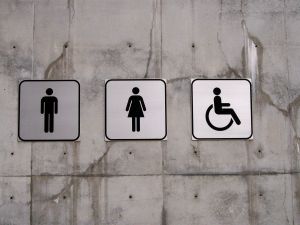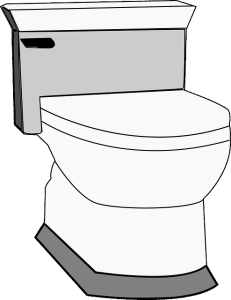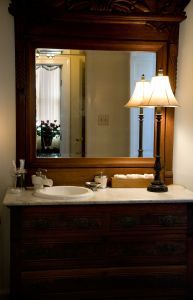 Teaching a child with Autism how to use a toilet can pose several different challenges. Even if you have success with potty training your child in your own home, some children with Autism have trouble adopting this new knowledge in other situations. There are also sensory issues to consider in the home and when using public restrooms. Some children with Autism have difficulty sitting on a hard toilet seat, have a hard time hearing the toilet flush, or are interested in flushing the toilet excessively, and then there are automatic toilets. There are also the noises of bathroom ventilation systems, leaky faucets, bright vanity lights, and odors from air fresheners, and daily bathroom use. At home, there are cold tile floors.
Teaching a child with Autism how to use a toilet can pose several different challenges. Even if you have success with potty training your child in your own home, some children with Autism have trouble adopting this new knowledge in other situations. There are also sensory issues to consider in the home and when using public restrooms. Some children with Autism have difficulty sitting on a hard toilet seat, have a hard time hearing the toilet flush, or are interested in flushing the toilet excessively, and then there are automatic toilets. There are also the noises of bathroom ventilation systems, leaky faucets, bright vanity lights, and odors from air fresheners, and daily bathroom use. At home, there are cold tile floors.
 To address hard toilet seats when you are toilet training your child, you can look into purchasing soft portable toilet seats that you can use in your home bathroom and take with you when you go to public restrooms. At home, placing a steep stool underneath your child’s feet can help with the feeling of anxiety caused by dangling feet. If a hard toilet seat does not bother your child but a cold toilet seat does, look into warming the toilet seat. For your home, you can purchase a toilet seat warmer, or run the hair dryer over the seat before your child sits down.
To address hard toilet seats when you are toilet training your child, you can look into purchasing soft portable toilet seats that you can use in your home bathroom and take with you when you go to public restrooms. At home, placing a steep stool underneath your child’s feet can help with the feeling of anxiety caused by dangling feet. If a hard toilet seat does not bother your child but a cold toilet seat does, look into warming the toilet seat. For your home, you can purchase a toilet seat warmer, or run the hair dryer over the seat before your child sits down.
Does your child run or shriek at the sound of a toilet flushing? While potty training, you can consider several different options. Because teaching a child with Autism to learn to use the toilet is hectic enough, you may simply just want to flush the toilet yourself when your child is not in the room or at a far enough distance where the sound does not bother him/her. You can also run faucet water or create white noise using an environment sounds CD when applicable. However, because the sounds of toilet flushing are an environmental sound that will never go away; you may want to desensitize your child to the sound using systematic desensitization. This may involve having your child stand near the door when you flush, gradually moving to having the child stand a few feet away, gradually moving closer to standing right near the toilet, to touching the flusher, then flushing themselves. If your child is interested in excessively flushing the toilet, encourage flushing only once and reinforce for flushing only once.
 If your bathroom lights cause sensory overload for your child, consider using light dimmers to help your child see and feel better in the bathroom. Turning off the light and using a small lamp or night light right near the toilet can help to create a sense of focus for your child as well. If bathroom smells bother your child, try airing out the place before your child goes in. Eliminate bathroom scents such as scented soaps and avoid spraying air fresheners when possible. Have your child wear socks in the bathroom to eliminate cold feet on the bathroom floor.
If your bathroom lights cause sensory overload for your child, consider using light dimmers to help your child see and feel better in the bathroom. Turning off the light and using a small lamp or night light right near the toilet can help to create a sense of focus for your child as well. If bathroom smells bother your child, try airing out the place before your child goes in. Eliminate bathroom scents such as scented soaps and avoid spraying air fresheners when possible. Have your child wear socks in the bathroom to eliminate cold feet on the bathroom floor.
Simply finding creative ways to manipulate your environment can help your child tolerate sensory overload in the bathroom.
For more help with potty training be sure to visit our other posts and pages:
Let’s Have a Poop Potty Party!
Potty Party Plan: The 1, 2, 3 so he will 1 and 2

